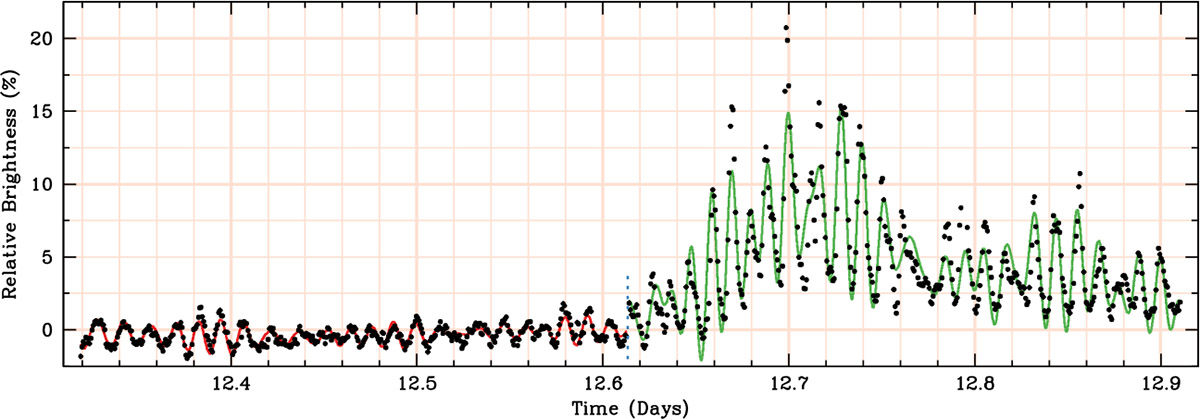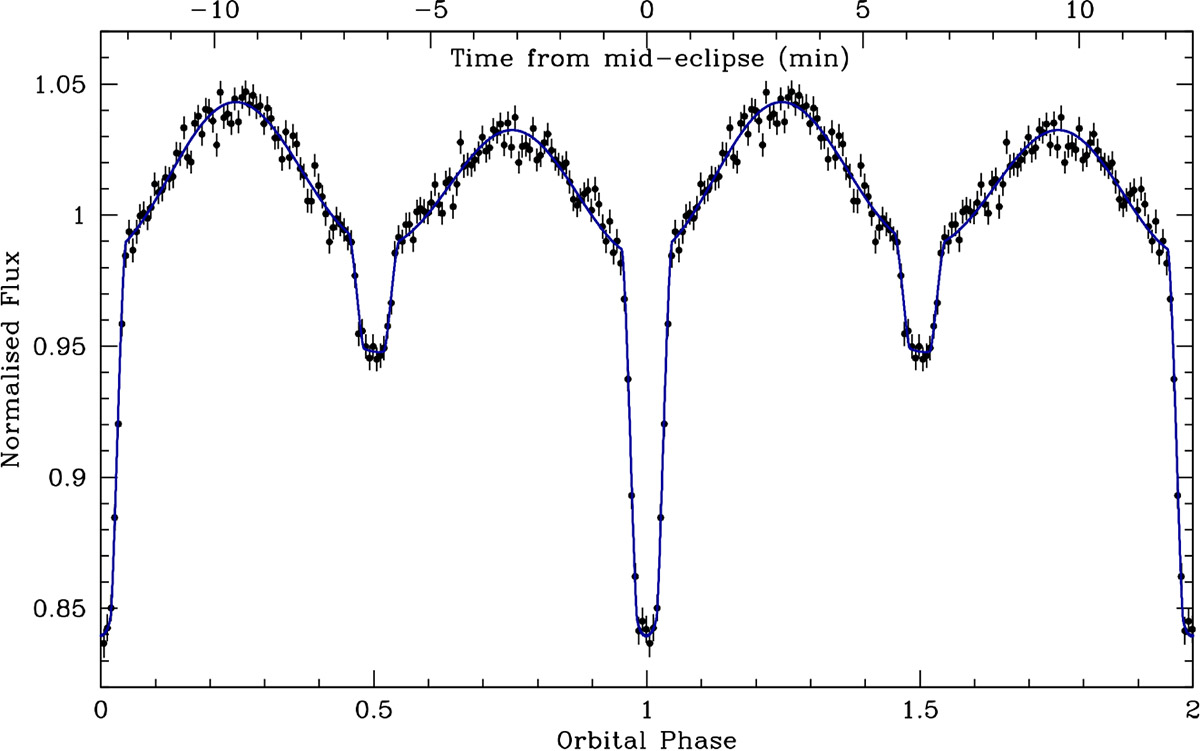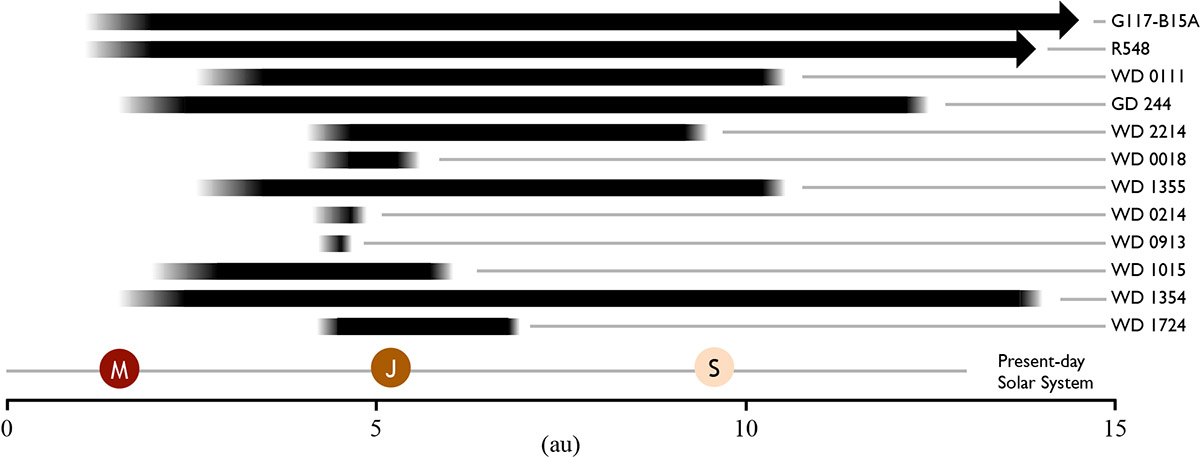
RESEARCH
My research interests converge on white dwarf stars, the final evolutionary state for more than 97 percent of all stars in our Galaxy, such as the core of the Cat's Eye Nebula in the Hubble telescope image above. In the past, I have used white dwarf stars as stable clocks, which are so interesting and diverse they can test general relativity, reveal the presence of planets, and allow us to watch stellar evolution on human timescales. I also use pulsating and binary white dwarfs to determine fundamental parameters of these burnt-out stars.
Please visit the BU White Dwarf group page for the most up-to-date information.
 The light curve of the pulsating white dwarf GD 1212, from the first publication using K2 data (Hermes et al. 2014a).
The light curve of the pulsating white dwarf GD 1212, from the first publication using K2 data (Hermes et al. 2014a).
White Dwarfs in Kepler/K2/TESS
I am PI of a major program to observe all known and high-probability white dwarfs with the Kepler and TESSspace telescopes. We have so far observed more than 2000 white dwarfs with at least 30-min cadence for more than 70 days from space, and hundreds have been sampled every minute. We are cataloging our raw and reduced data at k2wd.org. My primary interest is asteroseismology, but am extremely interested in what these data can say about remnant planetary systems around retired stars. We are also using the data to find and constrain new gravitational wave sources (e.g., Green et al. 2018, thread), short-period binaries (e.g., Parsons et al. 2017, thread) as well as new spotted white dwarfs with small magnetic field strengths (e.g., Hermes et al. 2017b). I am currently Deputy Chair of the K2 User's Panel and am co-chair of the working group dedicated to observing compact objects with TESS.
 A zoom in on an outburst from PG 1149+057, a completely new phenomenon we have discovered from Kepler monitoring of pulsating white dwarfs (Hermes et al. 2015b). The effect may be related to nonlinear mode coupling via parametric resonance, but the true cause is still under debate!
A zoom in on an outburst from PG 1149+057, a completely new phenomenon we have discovered from Kepler monitoring of pulsating white dwarfs (Hermes et al. 2015b). The effect may be related to nonlinear mode coupling via parametric resonance, but the true cause is still under debate!
White Dwarf Asteroseismology
Just as we can explore the interior of the Earth using seismology from earthquakes, we can unravel the inner secrets of stars using stellar pulsations, global stellar oscillations that respond differently depending on the internal composition of these objects. I specialize in observations of pulsating white dwarfs. As a graduate student, I discovered a new class of pulsating extremely low-mass white dwarfs (Hermes et al. 2012b), as well as the most massive, potentially ONe-core white dwarf known to pulsate (Hermes et al. 2013c; Astronomy Magazine article). More recently I have used Kepler and K2 for the longest monitoring of pulsating white dwarfs ever taken: our raw and reduced data are compiled at k2wd.org. With Kepler we are exploring white dwarf rotation in a whole new regime. We have also discovered a radical new outburst phenomenon in the coolest pulsating white dwarfs, likely from mode coupling via parametric resonance (Hermes et al. 2015b; Sky & Telescope article). I am fundamentally interested in what the starquakes of white dwarfs can tell us about the core and envelope structure of stars at the end stages of the life cycles, and how binary interaction can affect stellar structure (e.g., Hermes et al. 2015a).
 Using new K2 data paired with spectroscopy from the 4.1-m SOAR telescope, we have put the first constraints on white dwarf rotation as a function of mass (Hermes et al. 2017d). Most white dwarfs rotate at roughly 1.5 days, but the most massive white dwarfs appear to rotate faster (Hermes et al. 2017c)!
Using new K2 data paired with spectroscopy from the 4.1-m SOAR telescope, we have put the first constraints on white dwarf rotation as a function of mass (Hermes et al. 2017d). Most white dwarfs rotate at roughly 1.5 days, but the most massive white dwarfs appear to rotate faster (Hermes et al. 2017c)!
Endpoints of Stellar Rotation
White dwarfs offer us a glimpse into the future of stars like the Sun. Using the high-quality light curves from Kepler, we are exploring white dwarf rotation as a function of mass (Hermes et al. 2017c; AAS Nova article), as well as differential rotation as a function of radius in stellar remnants (Hermes et al. 2017a). We hope to use these observations to understand how and when stars lose their angular momentum. For example, if you completely conserve the angular momentum of a 2.5 solar-mass star initially rotating at 10 hr, that compact remnant should be rotating at just a few minutes, much faster than what we observe. We have shown with K2 that the vast majority of white dwarfs (which descended from 1.0-3.0 solar-mass stars) rotate at roughly 1.5 days (Hermes et al. 2017d). Our white dwarf rotation observations will hopefully shed new light on the endpoints of the internal transfer of angular momentum in stars.
 All white dwarfs <0.3 solar masses are by necessity the product of close binary interaction. This artist's impression shows an extremely low-mass white dwarf (left) and a smaller, more normal-mass white dwarf companion (Illustration: CfA/David A. Aguilar).
All white dwarfs <0.3 solar masses are by necessity the product of close binary interaction. This artist's impression shows an extremely low-mass white dwarf (left) and a smaller, more normal-mass white dwarf companion (Illustration: CfA/David A. Aguilar).
Extremely Low-Mass, He-Core White Dwarfs
I am interested in accurately determining the fundamental parameters of extremely low-mass (ELM) white dwarfs (<0.3 solar masses). These underweight, He-core white were first inferred (and later directly observed) as companions to millisecond pulsars, and are by necessity formed in close binaries. I have exploited brightness changes caused by their tidal deformations to constrain the radii of ELM white dwarfs (Hermes et al. 2014b). I have also explored why the lowest-gravity white dwarfs all show metals; it appears related to their relatively rapid rotation (Hermes et al. 2014c). But I have most enjoyed using the pulsations we discovered in several ELM white dwarfs (Hermes et al. 2013d) -- including one with a pulsar companion (Kilic et al. 2015) -- to explore their interiors using asteroseismology.
 The folded light curve of the 12.75-min WD+WD binary J0651+2844. In Hermes et al. (2012c) we showed the orbit of these two white dwarfs was shrinking rapidly due to the emission of gravitational waves.
The folded light curve of the 12.75-min WD+WD binary J0651+2844. In Hermes et al. (2012c) we showed the orbit of these two white dwarfs was shrinking rapidly due to the emission of gravitational waves.
Ultracompact Binaries
The degenerate nature of white dwarfs allows them to reside in extremely close orbits, too tight for stars like the Sun to exist without transferring material. Some white dwarfs have close low-mass or even substellar companions (such as the 71.2-min white dwarf plus brown dwarf binary described by Parsons et al. 2017). However, even more compact are WD+WD binaries -- these are the shortest-period binaries known where both stars are still detached.
I have spent several years searching for and monitoring eclipses in short-period binaries. My favorite system is J0651+2844, a 12.75-min doubly eclipsing WD+WD binary. In 2012 we used the changing mid-eclipse times to show that the orbit of both stars is decaying, exactly in line with the prediction from gravitational wave radiation (Hermes et al. 2012c; BBC News article) -- this is the cleanest optical detection of the effects of gravitational waves. We continue monitoring J0651+2844, and searching for new short-period eclipsing WD+WD binaries in K2 and future missions such as Gaia, TESS, and ZTF, and eventually the LSST with the Rubin Observatory.
 Cartoon depicting the regions around pulsating white dwarfs for which we can exclude the presence of 1.0 Jupiter-mass planets (Hermes et al. 2014). The search for surviving planets to white dwarfs is most sensitive using the pulsation timing method, described in a textbook chapter I have contributed: Hermes et al. (2018).
Cartoon depicting the regions around pulsating white dwarfs for which we can exclude the presence of 1.0 Jupiter-mass planets (Hermes et al. 2014). The search for surviving planets to white dwarfs is most sensitive using the pulsation timing method, described in a textbook chapter I have contributed: Hermes et al. (2018).
The Final Fate of Planetary Systems
Dedicated planet-hunting missions such as Kepler have shown us that planets are everywhere. We know from metal-polluted white dwarfs that roughly 25-50% of all stars have remnant planetary systems, but so far we have not directly detected surviving planets themselves. K2 data revealed a disintegrating asteroid closely orbiting a white dwarf roughly every 4.5 hours (Vanderburg et al. 2015), and now we are finding many more disintegrating transiting systems with ZTF (e.g., Vanderbosch et al. 2020, thread). I am very interested in the final fate of planetary systems around stars. I am currently co-I on a large HST program to determine the occurence rate of planetary debris around massive white dwarfs, which evolved from >3.5 solar-mass progenitors. I have also lead the most sensitive search for planetary companions around the final stages of stellar evolution, by monitoring the arrival times of stable pulsating white dwarfs. This method is described in more detail in a book chapter I contributed to the Handbook of Exoplanets (Hermes et al. 2018a). Eventually, I hope that astrometry with Gaia as well as long-term photometric surveys will eventually reveal intact remnant planetary systems around white dwarfs.
 The Transiting Exoplanet Survey Satellite (TESS), due to launch in 2018, will survey most of the sky down to roughly I=15.0 mag at 30-min cadence for at least 28 days.
The Transiting Exoplanet Survey Satellite (TESS), due to launch in 2018, will survey most of the sky down to roughly I=15.0 mag at 30-min cadence for at least 28 days.
The TESS Coeval Degenerate Survey
One of the most unique aspects of white dwarfs is that since they no longer produce energy from fusion, their evolution is fundamentally a cooling problem. This means that if you measure the temperature and mass of a white dwarf, you can use relationships to estimate its cooling age and thus its total age (including its main-sequence lifetime). I am interested to use this principle to determine the age of thousands of white dwarfs known in wide, common-proper-motion systems with main-sequence stars. The white dwarfs are coeval with their main-sequence companions, are typically wide enough to have not interacted, and their overall ages (ranging from hundreds of Myr to several Gyr) can calibrate age-rotation (gyrochronology) and age-activity relationships, as well as put ages on any potential planets discovered around what are typically cool main-sequence stars. I am currently a co-PI with Jennifer van Saders at UH-Manoa on an NSF-funded program to achieve these goals.
|